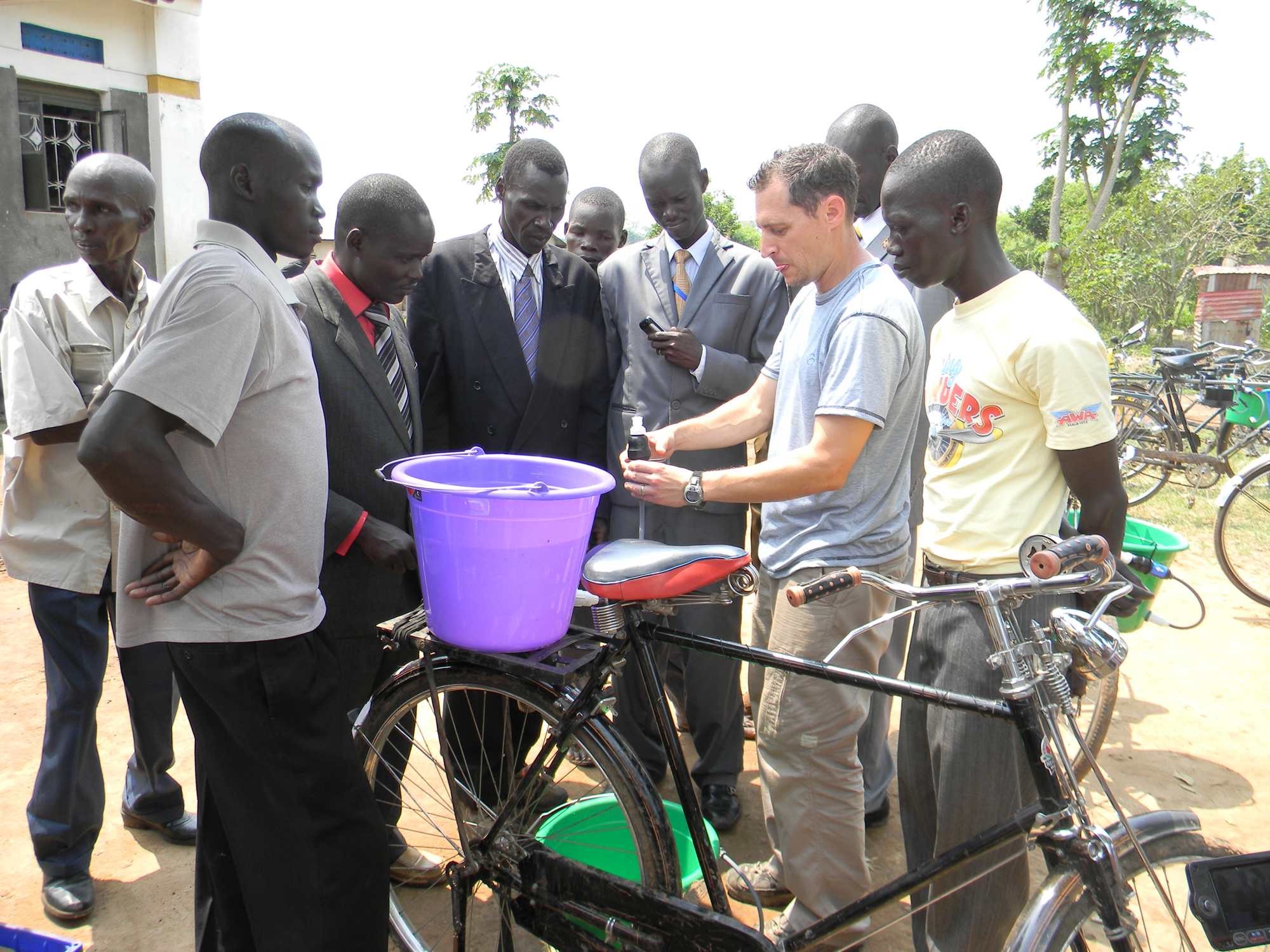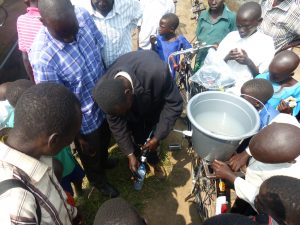
Chris Bond, BSME ’98, shows a group of men how to use a new water filter to remove harmful bacteria from their drinking water.
Chris Bond can remember the time he watched an old man smile from ear to ear as the man lit his home for the first time.
Just before, the two stood under the thatch roof of the man’s small mud home. The man plugged his lamp into the battery pack Bond had engineered, and the room was illuminated.
“He paused a minute, raised his hands in the air and gave me a hug,” Bond said.
More than three years ago, Bond, BSME ’98, came up with the idea of transferring the energy from a moving bicycle into a battery pack. The design inspired Bond to team up with his brother-in-law, Matthew Michalke, BSCE ’06. Working together, they used their engineering skills to launch Designs for Hope, a nonprofit organization devoted to design solutions for people living in developing countries.
“I’ve been able to use my education and my understanding of problem solving to be able to solve the needs of others who don’t have the resources to solve them themselves,” Bond said.
He had always had a knack for design. After graduating from The University of Alabama with a mechanical engineering degree in 1998, Bond took a job as a research and development engineer at Fontaine International, where he designed and modified products for the heavy trucking industry. He spent eight years there.

“I was getting unsatisfied with what I was doing, and so I began to see what else there was to do,” he said.
He soon left the plant to accept a teaching position at Hewitt-Trussville High School in Trussville, Alabama. Around that time he began traveling overseas to help with missionary efforts in developing countries.
Uganda, one of the places he has worked, where only 15 percent of the population has access to electricity, is one of Africa’s least powered nations, according to the latest estimates from the International Energy Agency. In rural areas, only 7 percent of Uganda’s people have access to electricity, the IEA estimates.
“They sit at home. They’re in the dark, and they can’t even see their family,” Bond said. “You can’t do chores, you can’t read, and you can’t study. Not only does everything stop when it gets dark, but it also becomes dangerous. They don’t typically go outside because of snakes and other nocturnal animals.”
As part of a class project where groups had to solve a real-world problem, ideas were being generated. Then it hit him: What if he could harness the energy from a bicycle to create a rechargeable battery for those who have no access to the electrical grid?
Taking the project on himself, he took an AC generator and applied the principles of Faraday’s Law that states any change in the magnetic environment of a coil of wire will cause a voltage to be induced in the coil. Using this principle, he used the rotation of the bicycle wheel to generate electrical currents that then travel through a custom circuit and safely into the battery pack.
“People in Africa are already pedaling their bicycles every day,” Bond said. “Now they can harness their energy to be used later on.”
Not only does their product provide lights to a once dark region, it is a great way to charge cellphones.

Thanks to investments made by cellphone-service providers, developing countries now have unprecedented access to mobile phones. For instance, nearly 60 percent of Ugandans own a mobile phone, according to a 2013 survey by the Pew Research Center. An analysis of data collected by the World Bank shows people in Uganda have greater access to mobile phones than sanitation or electricity.
“There are actually more cellphones in sub-Saharan Africa than there are toilets, so the need to charge cellphones is a really big deal,” Bond said.
During his trips, he noticed keeping phones charged could be a burden. Typically, people living in rural areas of Uganda travel miles by foot or bicycle to pay about 20 cents to use a charging station in an urban area. The trip can take days.
“Most of these people make about a dollar or a dollar fifty a day, so that 20 cents is a pretty significant cost for them,” Bond said. “They’re mostly farmers or laborers of some sort, so they lose a day or two working when they make the trip.”
While most in Uganda and other developing countries cannot afford a monthly subscription, street vendors offer mobile access on a per-call basis, Bond said.
“Using this product will provide them the ability to charge not only their phones but the phones of the people in their community, and it will cut down their need to travel into the cities, wasting their time and resources,” Bond said.
Today, Designs for Hope is funded by donations and grants and has supplied more than 100 battery packs to the developing world. The energy harnessed from bicycles is capable of lighting a single home for up to 18 hours, and a single battery pack can charge up to nine cellphones, Bond said.
To learn more about Designs for Hope and its sustainable solutions, visit designsforhope.org.
Designs for Hope now works in an additional six regions including, Nicaragua, Niger, Sudan, Zambia, Madagascar and India. Since missionary work is a key function of the organization, it maintains partnerships with established churches in each country.
“Typically, people and organizations will approach us about a region of the world they are working in that has needs similar to those we have encountered,” Bond said. “We mostly work with missionaries, churches and other grass-roots organizations that have an established connection with the people of those regions. We will offer our product to them, train them to use it effectively and then they take it to those they work with.”
In addition to the bicycle battery packs, Designs for Hope has since introduced water-filtration systems. Bond estimated that roughly 70 percent of a village in a country like Uganda is usually sick with a water-borne illness. According to Bond, the filtration systems provided by Designs for Hope can filter up to a million gallons of water at a time, and he estimated that one filter can serve about 100 people for a span of five years.
“We’re using our engineering skills to tackle these problems,” Bond said. “If I wasn’t an engineer, this would never have happened.”